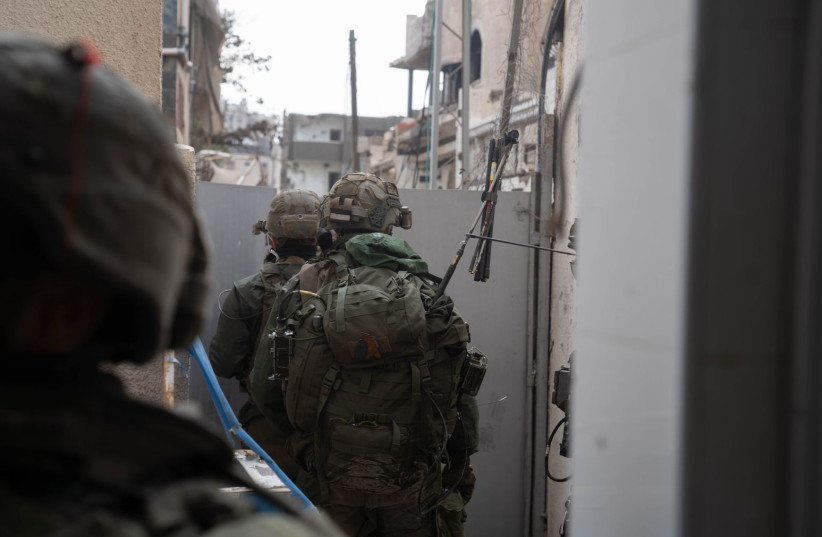The IDF is trying to consolidate its initial operational control in northern Gaza into long-term stability and trying to prevent the return of Hamas.
To accomplish this, it is engaging in mopping up operations against an estimated 2,000 Hamas terrorists who are hidden and dispersed into smaller, often disconnected cells throughout the northern area.
In the past week, according to the military, troops from the 162nd Division initiated a raid in the north and center of Gaza City and in Al-Shati.
The IDF said that in the last four days it had killed 200 Hamas fighters, a pace of eliminating Hamas forces far below the first few weeks when the military killed several thousand.
However, that pace of raiding and killing Hamas forces is significantly higher than what had been for the last month when the IDF was not confronting or being confronted by Hamas in any high volume.
In the face of reports that Hamas is trying to reestablish civilian aspects of its rule with unarmed operatives handing out money, supplies, and directives, IDF sources said they are addressing these issues and will not allow them to grow into any organized resistance.

Civilian aspect of the war
At the same time, IDF sources do not have an answer to managing the civilian aspects of the lives of 150,000-200,000 northern Gazans remaining in the area given that the government has not come close to deciding what should happen next.
This delay has been caused by internal disagreements within the government as well as disagreements with the US, EU, and Arab allies, who all want a role for the Palestinian Authority in Gaza.
The IDF believes that it could easily take a full year throughout 2024 to slowly root out the remaining hiding Hamas agents, but sources did not want to address a scenario where they are given significantly less time by the government and the world, other than to say they will carry out their mission in whatever time table they are given.
Moreover, IDF sources admitted that current northern operations have not led to freeing additional hostages from Hamas, but they said that keeping pressure on Hamas in northern Gaza and maintaining a cut-off from southern Gaza were major bargaining chips to play against Hamas to get the hostages back.
Further, the IDF said that the earlier hostage exchange deal of November 23-30 was achieved by virtue of the military's success in northern Gaza.
Finally, the IDF noted that it had managed to unite the Nahal and 401 brigades traveling all the way across northern Gaza in only about 90 minutes without almost any resistance, whereas the same trip in October-November took three full divisions multiple weeks to move through some areas, and several days in others.
Hamas fired only one rocket on Monday, with a siren at Yad Mordechai near the southern border.
Defense Minister Yoav Gallant on Monday said that there is no place where Hamas can hide, including Rafah.
He said the IDF has beaten more than half of Hamas's forces.
In addition, at an organizational level, he said the victory was larger, having taken apart 18 of Hamas's 24 battalions.
Gallant said that three of four Khan Yunis battalions have been taken apart, with the fourth in western Khan Yunis on the verge of falling.
He added that the IDF can now move throughout Gaza quickly and without almost any resistance.
Moreover, he said that continuing military attacks, including to Rafah and the Deir Al Balah part of central Gaza, will lead to returning the hostages held by Hamas.
Further, he said IDF forces have recently found new intelligence to track Hamas's leader and the hostages.
The defense minister said Gaza Chief Yahya Sinwar had transformed from the leader of Hamas to a coward running for his life from tunnel to tunnel.
In addition, Gallant called on the cabinet, which he is part of but which Prime Minister Benjamin Netanyahu still holds the most sway over, to move forward with diplomatic decisions very soon so as not to squander the IDF’s achievements.
Gallant’s call to move forward with “The Day After” plans for Gaza, also being urged by the US and Israeli allies, was the second time he has made the call in recent weeks, after pressing Netanyahu publicly on January 15.
The defense minister repeated his mantra for the North that he intended to return the 80,000 evacuated residents with a deal with Hezbollah or by a larger military operation if necessary – but with no hint that the issue was actually close to resolution.
In the North, Hezbollah continued to fire rockets on northern Israel on Monday, though with only six sirens, the volume dropped significantly as compared to the 33 sirens on Monday.
IDF artillery units, along with IAF jets, attacked numerous Hezbollah targets in Lebanon, including Levona, and the villages of al-Jabin, Beit Leif, and Raashit.
